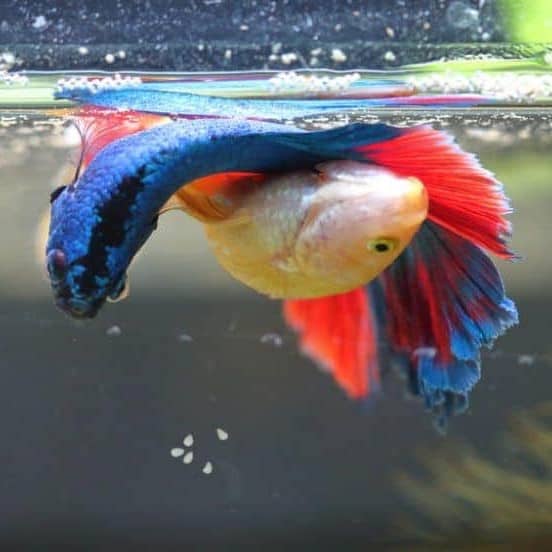Last Updated on October 8, 2020
Breeding Betta fish as a hobby or for profit is a rewarding experience. You can learn so much about the Betta fish’s behavior and life cycle when you pursue this project. Male and female betta fish will have certain requirements you need to provide before they can mate.
Let us talk about how long it takes for betta fish to mate and the things you can do to increase your chances of having lots of Betta fry.
Table of Contents
How long does it take for betta fish to mate?
Let’s get straight to the point:
The entire process of introducing the male and female to each other and finally mating will be around 2 weeks to 1 month. It is possible that it may take another month until they mate. This process will require your patience.
There may be times when pairing will be unsuccessful. Do not let this discourage you. Keep trying until you succeed.
What age do Betta fish breed?
It is good practice that you breed Bettas when they’re still young. Ideally 4-12 months; max-age 14 months. This is because they are a lot healthier when they are young.
How to differentiate Males from the Females in Bettas?
Adult males are larger. 3 inches for males. 2.25 inches for females. Male Bettas are longer and more slender. Females are shorter and wider.
Male betta fish have longer fins compared to the female betta. The male betta has a more prominent beard compared to that of the female.
Females have an egg spot when they are egg bound. Females may display vertical bands when they will mate.
Male betta fish usually create a bubble nest in their territory.
Related: How To Know If Betta Fish Is Male Or Female?
Why do you want to breed Betta fish?
Breeding Betta fish takes effort. Successfully breeding Betta fish will also mean that you must have enough resources to take care of the baby Bettas also known as fry.
Breeders usually do this because they:
- Want more bettas to sell in their store or to supply local fish shops.
- Are trying to breed good quality Betta fish to compete in shows.
- Are perfecting a certain strain of Betta that will showcase winning traits such as rare tail types, rare colors, and patterns.
You might be a successful breeder in the making! Hopefully, this article helps you through this new stage of Betta fish care. Please do not go into this half-heartedly because you will need to be responsible for a lot of baby Bettas soon.
What materials do I need for a Betta breeding setup?
Tank
You will need a tank for the male betta and another tank for the female betta. Then you will need a breeding tank where the male and female will mate. You need separate tanks for the male and female because you cannot keep them together long-term.
The breeding tank will also be where the eggs will hatch to baby fry. You need a separate breeding tank because you will need to remove the parents as part of the process. Then you may probably need more tanks to house each baby as it grows up and starts becoming territorial.
Now you are seeing why this isn’t a project to take lightly!
Heater
We will need an aquarium heater for the breeding tank. We should keep the water temperature at 28 degrees Celsius or 82 degrees Fahrenheit, which is optimal for breeding.
Ensure that you can cover the breeding tank with a lid or plastic wrap so that a humid, warm air space exists above the water surface. Betta breeding is also possible within the range of 26 to 30 degrees Celsius or 80 to 86 degrees Fahrenheit. Some breeders have excellent results at temperatures around 84oF.
Filter
We need an air-driven sponge filter which has matured for the breeding tank. This will contain beneficial bacteria essential for keeping the water column clean. Sponge filters will also contain microorganisms, which will serve as food for the fry.
Live plants
Live plants will provide shelter for fish during the breeding process. Use hardy plants that require little light. Examples are java fern, anubias, and java moss. Plants will provide a propagation surface for microorganisms which will serve as initial food for the fry.
Related: Do Betta Fish Like Live Plants
Indian Almond
Indian Almond (Terminalia catappa) leaves can treat the water of the breeding tank. It has become very popular as a natural medicine and water conditioner for aquarium use. This leaf has anti-bacterial and anti-fungal properties which will protect the breeding pair and their young.
Fish breeders are known to use these leaves to give their fish an environment suitable for spawning. They help increase the health, vigor, and fertility of fish and reduce the pH levels of the water column. Breeders use the leaves to imitate the natural conditions of the Betta’s natural habitat through the release of tannins and tannic acid.
Do not be surprised when you notice the color of the breeding tank turns slightly yellow. This change of color is because of the tannins released by the leaf and is normal.
The floating leaf also provides a surface on which a male betta can start making its bubble nest. The slightly lower pH triggers the instinct of the Betta to mate.
The leaf breaks down throughout the days in the aquarium water. This will provide food for small microorganisms called infusoria. These microorganisms will be a substantial food source for the fry.
You can purchase Ocean Nutrition Betta SPA with Wild Almond Leaf Extract online if you do not have any Indian Almond trees in your area.
Cover
A cover for your breeding aquarium such as a polycarbonate sheet will be needed to give the pair some privacy. You also need this to maintain temperature.
Related: Do Betta Fish Need a Lid on Their Tank?
Divider
A clear tank divider or a clear glass bottle allows the pair to first see each other without the risk of sudden fights. This is important when you first introduce the pair.
Steps in breeding Betta Fish

Step 1: Choose the pair to breed. Look for young and healthy fish without any signs of disease. Choose a male betta that shows off its gills and fins through flaring and fanning. Choose fish that do not have deformities.
Step 2: This is the conditioning phase for the pair. Place them into separate tanks for at least two weeks. Ensure good water conditions and feed with high-quality food.
Live foods are the best option. You can also feed baby brine shrimp once in a while. The parents will think there is enough food for baby fish and this will trigger them to spawn.
They need to store much energy during this phase. The mating process requires a lot of energy and effort from both fish.
Step 3: Set up the breeding tank. The breeding tank should have a water depth of 3 to 5 inches. Water level which is too deep is not suitable for fry because it will prevent them from easy access to the surface.
Install the mature filter, heater, plants, and place one Indian almond leaf. Make sure it floats on the surface to allow the male to attach a bubble nest to it. Place the divider if you have it on hand.
Step 4: Put the male into one portion of the tank with the Indian almond leaf and the female in another. They should see each other through the clear divider. The male will try to impress the female through gill flaring and fin fanning.
He will try to show his colors, his movement will increase, and seem to nip at the female. The female may choose to ignore the male at this point. This is normal and may take a few tries before she is receptive.
Once the female is receptive she will show a vertical color along her side midsection. This is a barring pattern. Her egg spot or ovipositor will be more noticeable.
A female may also flare back at the male, move her body in a wagging manner, and try following the movement of the male.
Step 5: Wait for the male to build a bubble nest. This may take a few hours to as much as a day. You may leave them separated through the night but place the cover to create privacy and to allow the temperature to remain stable.
Step 6: Remove the divider and observe their behavior. The female should be rather receptive and not fight back too much. It is normal to have some fin nipping but be sure to intervene when the fights get too intense.
Step 7: The mating dance will continue and you may see them trying to bite each other. Once the female is finally receptive, the embrace occurs. This looks as though the pair wraps around each other’s body in a steady pose.
During this embrace, the female releases her eggs while the male fertilizes it. This may occur several times. Be on the lookout though because the female may start eating the eggs.
The male will start picking up the eggs that have fallen to the bottom using his mouth. He will place the eggs onto the bubble nest. He may actually start eating some of the eggs though.
Step 8: Take the female out of the tank when you no longer observe any embrace happening. This will also prevent the male from attacking the female which he will now consider as a threat to the eggs. Put her back into her own tank.
Step 9: Leave the male to tend to the eggs for at least 2 to 3 days. Cover the tank during this part and avoid disturbing it. Once the fry is free swimming you can remove the male and put him back into his own tank.
The infusoria will serve as food for the hatched betta fry for the first 7 days. You can introduce live food such as vinegar eels and baby brine shrimp next.
Congratulations! You have started your journey in breeding Betta fish. We wish you the best!
